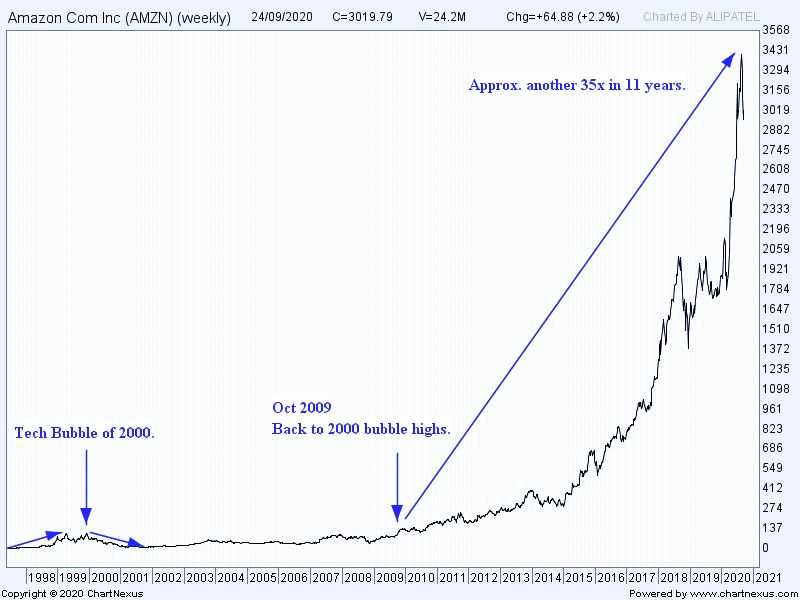Bubbles come and burst they do!
- Ali Godrej Patel

- Sep 26, 2020
- 3 min read
Now we all know what a 'bubble' is, but in financial terms, it is the rapid increase in price of an asset. Reasons for this can be many - economic prosperity, investment rotation, speculation, but the underlying factor being market sentiment and behavior. Bubbles typically 'pop' or 'burst', resulting in a severe downturn of asset prices. Several bubbles have come and gone. Let us touch base on the ones that I have personally witnessed; the housing/credit bubble of 2007 and the tech/dotcom bubble of 2000.
My uncle (dad's younger brother) lives in Arlington, Texas. In 2010, he purchased the home that he currently lives in. This was right after the credit/housing bubble and the financial crisis. Back then, housing prices had fallen between 30-40% and he was able to capitalize. Today, his property has doubled in value. One can argue that the extent of price fall and subsequent appreciation has not been the same in other cities/states in the US, but that is the whole point! Opportunities will always vary and one will always supersede the other. Just like stocks, be it in same or different geographies/sectors.
Moving to the tech/dotcom bubble of 2000; during the late 90s, the rise of the internet resulted in money being poured into ecommerce, communication and technology. Several companies made stupendous peaks followed by devastating crashes, some not surviving and going bust. Many that survived have not yet reached their peak levels. This being said, there have been exceptions. To study this, let us have a look at 2 stocks: Infosys (NSE: INFY) and Amazon (NASDAQ: AMZN). (The charts below account for price adjustments due to corporate actions)
Infosys listed on the Indian stock exchanges in 1993 and was the first Indian company to list on the Nasdaq in 1999. A well known name in the software, consulting and outsourcing space, Infosys attracted significant investments in the 90s. When the tech bubble popped, Infosys was no exception and fell approximately 85% from its previous highs.

These were testing times. However, we know that seasoned investors are usually in it for the long haul. If you look at the chart below, the bubble of 2000 makes it seem like as if Infosys was only getting started. In which ever way you look at it, you would have been a winner investing (and holding) in Infosys. The sell off in March 2020 due to COVID-19 was no different. INFY fell to sub 550 levels and handsomely rallied to 1000+.

Next up, amazing Amazon, the online bookstore that listed on the Nasdaq in May 1997. Let us go back in time and see what history has for us.

The stock appreciated by approximately 60 times in 2 years and once it popped, it fell by over 90%. Not much for those who got in early and a devastating situation for those who got in at the top. What happened after that?

Well, it did take approximately 10 years for Amazon to break above its all time highs of 2000. Not to forget, that in itself was 20 times if you purchased it in 2002. But post that, Amazon's ability to transform to an ecommerce giant and other leading initiatives like cloud computing with Amazon Web Services (AWS) made it an impeccable investment.
As of now, we are seeing similar investment behavior resulting in a tech boom. Companies centering their strategy around data analytics, cloud computing, artificial intelligence, 5G, augmented reality and virtual reality are in the limelight experiencing a similar surge in stock prices. IPOs are appreciating by 100% on the first day of listing, be it healthcare tech, bio-tech, food tech, insurance tech, payment tech or security tech.
The questions now are: Do we have another bubble on the way? Nasdaq/tech again? How worried are we supposed to be? Should we ride the wave? Or should we panic and walk away completely? Can we sensibly hedge if we are able to forecast the top?
The outcomes of previous bubbles do not guarantee what is to come, but the data can always allow us make informed investment decisions and manage risk accordingly.
Share your thoughts in the comments section below.
All the best and happy investing!
Ali Godrej Patel
Disclaimer: I currently do not hold Infosys or Amazon.




Very informative article. You have explained so nicely with great examples.
Great article. Very well explained.
Hi Sunil, that is correct, the current rally in tech is definitely a beneficiary of COVID. Even if you look at the charts above, you will see that there were spikes around 1997and 1998 followed by the major escalation of price in 1999, which you refer to. Considering Amazon, its price is already 30 times of that in 2010. If it doubles from here, we are talking 60 times. There are many other examples of this kind of price action in veterans like Microsoft, Nvidia; but leaving them aside, to back up with new kids on the block; Shopify listed in 2015, it is already trading at 35 times its list price, with majority of appreciation over the last year.…
Current scenario do not looks like bubble in Tech companies...Bubbles created after phenomenon rise in price like 10 times to 50 times in short time. Currently it looks like correction rather than bubble burst in Tech companies. Even the recent situation (covid 19) will be good for this sector.